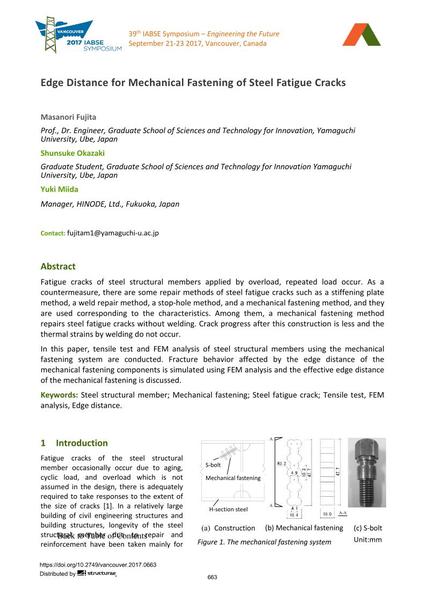Edge Distance for Mechanical Fastening of Steel Fatigue Cracks

|
|
|||||||||||
Bibliografische Angaben
| Autor(en): |
Masanori Fujita
(Prof., Dr. Engineer, Graduate School of Sciences and Technology for Innovation, Yamaguchi University, Ube, Japan)
Shunsuke Okazaki (Graduate Student, Graduate School of Sciences and Technology for Innovation Yamaguchi University, Ube, Japan) Yuki Miida (Manager, HINODE, Ltd., Fukuoka, Japan) |
||||
|---|---|---|---|---|---|
| Medium: | Tagungsbeitrag | ||||
| Sprache(n): | Englisch | ||||
| Tagung: | IABSE Symposium: Engineering the Future, Vancouver, Canada, 21-23 September 2017 | ||||
| Veröffentlicht in: | IABSE Symposium Vancouver 2017 | ||||
|
|||||
| Seite(n): | 663-669 | ||||
| Anzahl der Seiten (im PDF): | 7 | ||||
| Jahr: | 2017 | ||||
| DOI: | 10.2749/vancouver.2017.0663 | ||||
| Abstrakt: |
Fatigue cracks of steel structural members applied by overload, repeated load occur. As a countermeasure, there are some repair methods of steel fatigue cracks such as a stiffening plate method, a weld repair method, a stop-hole method, and a mechanical fastening method, and they are used corresponding to the characteristics. Among them, a mechanical fastening method repairs steel fatigue cracks without welding. Crack progress after this construction is less and the thermal strains by welding do not occur. In this paper, tensile test and FEM analysis of steel structural members using the mechanical fastening system are conducted. Fracture behavior affected by the edge distance of the mechanical fastening components is simulated using FEM analysis and the effective edge distance of the mechanical fastening is discussed. |
||||
| Stichwörter: |
Zugversuch Randabstand FEM-Untersuchung
|
||||
